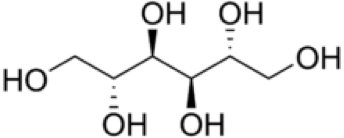
Mannitol is also known as mannite or manna sugar and is a white, crystalline solid. Mannitol is an odorless white crystalline powder or free-flowing granules and tastes sweet like sucrose, which is a common, naturally occurring carbohydrate found in many plants and plant part. The chemical molecular formula of Mannitol is C6H14O6 and soluble in water, more soluble in hot water.
Scientists at Creative Proteomics utilize a highly quantitative method with high-performance liquid chromatography (HPLC) for the determination of Mannitol levels in various samples, including Food, Beverage and more. High-Performance Liquid Chromatography (HPLC) using a differential refractive index detector (RID) for the determination of Mannitol levels in a lot of biological samples. This Methodology provides accurate, reliable, and reproducible results of Mannitol measurement, which enables us to analyze of Mannitol levels in vitro and in vivo.
Mannitol can be used to decrease the intracranial pressure raised acutely before more specific treatment is applied, for example, the sudden head trauma. Mannitol is also can be applied to decrease the pressure in the eye, increase the elimination of certain toxins, ciguatera fish poisoning, and to treat fluid build up in the case of kidney failure with low urine output. Mannitol also sold as a laxative for children due to Mannitol can act as an osmotic laxative in oral doses larger than 20 g. The use of Mannitol as a bronchial irritant as an alternative Method to diagnose the exercise induced asthma has been proposed, however, a review published in 2013 suggested that there is no sufficient evidence to support Mannitol as an alternative Method to diagnose the exercise induced asthma. Mannitol also is the drug in the first line to treat the acute glaucoma in veterinary medicine. In addition, Mannitol can be used as a sweetener in chewing gums for people with diabetes due to Mannitol increases blood glucose to a lesser extent than sucrose.
The Russian-Polish botanist M. Tswett is generally recognized as the first person to establish the principles of chromatography. In a paper he presented in 1906, Tswett described how he filled a glass tube with chalk powder (CaCO3) and, by allowing an ether solution of chlorophyll to flow through the chalk, separated the chlorophyll into layers of different colors. He called this technique “chromatography”. Fundamentally, chromatography is a technique used to separate the components contained in a sample. High Performance Liquid Chromatography (HPLC) is a method able to separate non-volatile, thermally unstable, and polar components separate or in a mixture. HPLC is a type of chromatography that, because of its wide application range and quantitative accuracy, is regarded as an indispensable analytical technique, particularly in the field of organic chemistry. It is also widely used as a preparation technique for the isolation and purification of target components contained in mixtures.
Mannitol Analysis Service at Creative Proteomics supports your research in Mannitol Analysis. HPLC Based Analysis Service Platform enable us at Creative Proteomics offers you a state-of-the-art Analysis Service.
Sample Type
Food, Beverage and more
Method
High-Performance Liquid Chromatography (HPLC) using a differential refractive index detector (RID) for the determination of Mannitol levels in a lot of biological samples. This Methodology provides accurate, reliable, and reproducible results of Mannitol measurement, which enables us to analyze of Mannitol levels in vitro and in vivo.
Send us your samples, you will get all information that you need!







